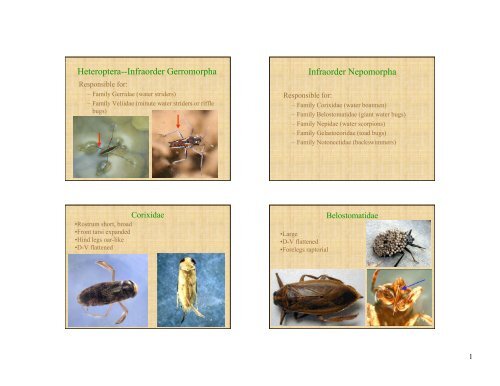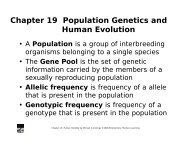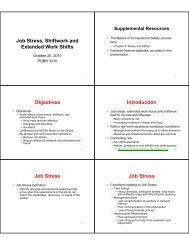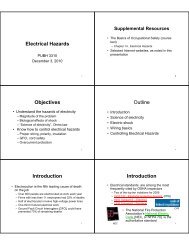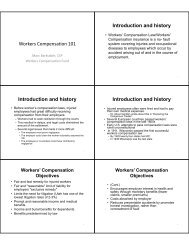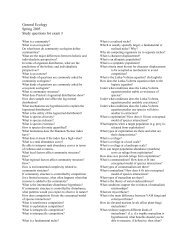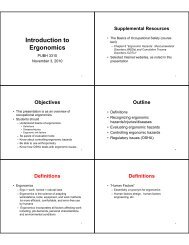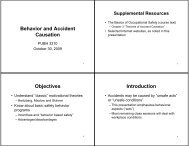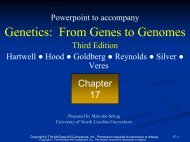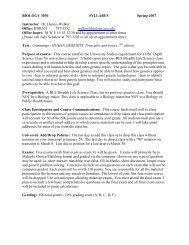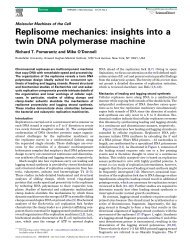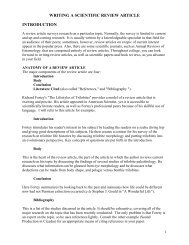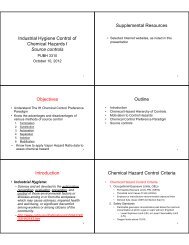Heteroptera--Infraorder Gerromorpha Infraorder Nepomorpha
Heteroptera--Infraorder Gerromorpha Infraorder Nepomorpha
Heteroptera--Infraorder Gerromorpha Infraorder Nepomorpha
You also want an ePaper? Increase the reach of your titles
YUMPU automatically turns print PDFs into web optimized ePapers that Google loves.
<strong>Heteroptera</strong>--<strong>Infraorder</strong> <strong>Gerromorpha</strong><br />
Responsible for:<br />
– Family Gerridae (water striders)<br />
– Family Veliidae (minute water striders or riffle<br />
bugs)<br />
Corixidae<br />
•Rostrum short, broad<br />
•Front tarsi expanded<br />
•Hind legs oar-like<br />
•D-V flattened<br />
<strong>Infraorder</strong> <strong>Nepomorpha</strong><br />
Responsible for:<br />
– Family Corixidae (water boatmen)<br />
– Family Belostomatidae (giant water bugs)<br />
– Family Nepidae (water scorpions)<br />
– Family Gelastocoridae (toad bugs)<br />
– Family Notonectidae (backswimmers)<br />
•Large<br />
•D-V flattened<br />
•Forelegs raptorial<br />
Belostomatidae<br />
1
Nepidae<br />
•Legs long, slender<br />
•Forelegs raptorial<br />
•Posterior abdominal air tube<br />
Notonectidae<br />
• Similar to corixids but not D-V<br />
flattened<br />
• Rostrum slender<br />
• Front tarsi slender<br />
Gelastocoridae<br />
•Toad-like (including hop)<br />
•Bulging eyes<br />
•Aquatic margins<br />
<strong>Infraorder</strong> <strong>Nepomorpha</strong><br />
Saldidae<br />
•Black or greyish<br />
•Distinct “neck”<br />
•Wing membrane with 4-5 long closed cells<br />
2
<strong>Infraorder</strong> Cimicomorpha<br />
Responsible for:<br />
– Family Reduviidae (assassin bugs)<br />
– Family Phymatidae (ambush bugs)<br />
– Family Miridae (leaf/plant bugs)<br />
– Family Tingidae (lace bugs)<br />
– Family Nabidae (damsel bugs)<br />
– Family Anthocoridae (minute pirate bugs)<br />
– Family Cimicidae (bed bugs)<br />
Phymatidae<br />
•(Text treats as subfamily)<br />
•Front femur strongly thickened<br />
•Last antennal segment swollen<br />
Reduviidae<br />
•Constriction between head and thorax (“neck”)<br />
•3-segmented rostrum, fits in prosternal groove<br />
•Transmit Chagas disease (trypanosome)<br />
Miridae<br />
•Front wing with cuneous, bent downward towards<br />
apex abdomen<br />
•Membrane with 2 cells<br />
cuneus<br />
3
Tingidae<br />
• Dorsum and wings<br />
with reticulate pattern<br />
• Lacy appearance<br />
Anthocoridae<br />
•D-V flattened<br />
•black with white markings<br />
•beak 3-segmented<br />
•hemelytra with cuneus<br />
•Few or no veins in membrane<br />
Nabidae<br />
• Small<br />
• Slender body<br />
• Rostrum 4segmented<br />
• Many marginal cells<br />
on membrane<br />
• Wingless<br />
• Body flat<br />
Family Cimicidae<br />
4
Responsible for:<br />
Pentatomomorpha<br />
– Family Pentatomatidae (stink bugs)<br />
– Family Scutelleridae (shield-backed bugs)<br />
– Family Lygaeidae (seed/cinch bugs)<br />
– Family Coreidae (leaf-footed/squash bugs)<br />
– Family Rhopalidae (scentless plant bugs)<br />
Scutelleridae<br />
• Similar to Pentatomidae<br />
but scutellum extending to<br />
apex of abdomen<br />
Pentatomatidae<br />
• Antenna 5-segmented<br />
• Scent glands<br />
• Large triangular<br />
scutellum but not longer<br />
than corium<br />
Lygaeidae<br />
• scent glands present<br />
• Rostrum 4-segmented<br />
• membrane of hemelytra with<br />
only 4-5 veins<br />
5
Coreidae<br />
• membrane of hemelytra<br />
with many veins<br />
• head narrower and shorter<br />
than pronotum; no<br />
constriction behind head<br />
• scent glands present<br />
between middle and hind<br />
coxae<br />
• hind tibiae sometimes<br />
dilated and leaflike;<br />
Rhopalidae<br />
• membrane of hemelytra<br />
with many veins<br />
• many species are black<br />
and red/orange (boxelder)<br />
• 10 mm or less<br />
• scent glands absent<br />
6


